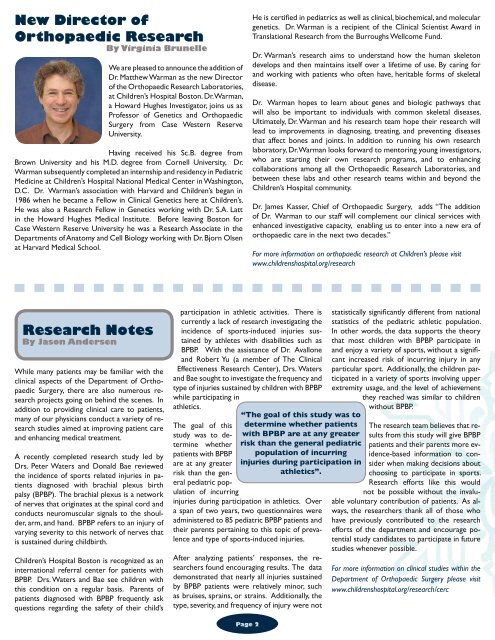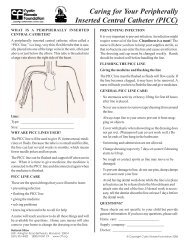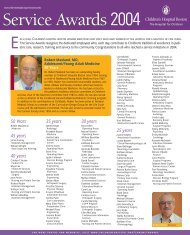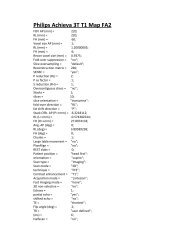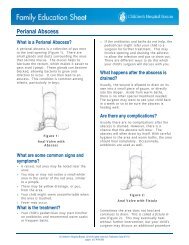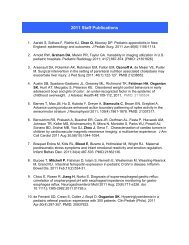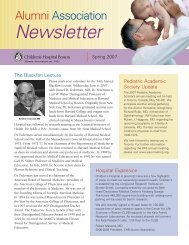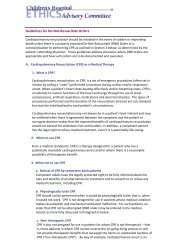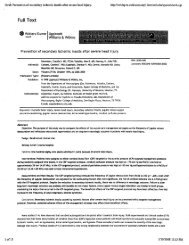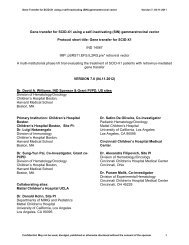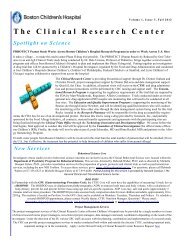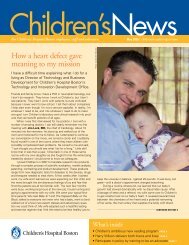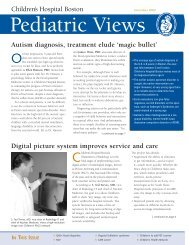Ortho times - Children's Hospital Boston
Ortho times - Children's Hospital Boston
Ortho times - Children's Hospital Boston
You also want an ePaper? Increase the reach of your titles
YUMPU automatically turns print PDFs into web optimized ePapers that Google loves.
new director of<br />
<strong>Ortho</strong>paedic Research<br />
By Virginia Brunelle<br />
We are pleased to announce the addition of<br />
Dr. Matthew Warman as the new Director<br />
of the <strong>Ortho</strong>paedic Research Laboratories,<br />
at Children’s <strong>Hospital</strong> <strong>Boston</strong>. Dr. Warman,<br />
a Howard Hughes Investigator, joins us as<br />
Professor of Genetics and <strong>Ortho</strong>paedic<br />
Surgery from Case Western Reserve<br />
University.<br />
Having received his Sc.B. degree from<br />
Brown University and his M.D. degree from Cornell University, Dr.<br />
Warman subsequently completed an internship and residency in Pediatric<br />
Medicine at Children’s <strong>Hospital</strong> National Medical Center in Washington,<br />
D.C. Dr. Warman’s association with Harvard and Children’s began in<br />
1986 when he became a Fellow in Clinical Genetics here at Children’s.<br />
He was also a Research Fellow in Genetics working with Dr. S.A. Latt<br />
in the Howard Hughes Medical Institute. Before leaving <strong>Boston</strong> for<br />
Case Western Reserve University he was a Research Associate in the<br />
Departments of Anatomy and Cell Biology working with Dr. Bjorn Olsen<br />
at Harvard Medical School.<br />
Research notes<br />
By Jason Andersen<br />
While many patients may be familiar with the<br />
clinical aspects of the Department of <strong>Ortho</strong>paedic<br />
Surgery, there are also numerous research<br />
projects going on behind the scenes. In<br />
addition to providing clinical care to patients,<br />
many of our physicians conduct a variety of research<br />
studies aimed at improving patient care<br />
and enhancing medical treatment.<br />
A recently completed research study led by<br />
Drs. Peter Waters and Donald Bae reviewed<br />
the incidence of sports related injuries in patients<br />
diagnosed with brachial plexus birth<br />
palsy (BPBP). The brachial plexus is a network<br />
of nerves that originates at the spinal cord and<br />
conducts neuromuscular signals to the shoulder,<br />
arm, and hand. BPBP refers to an injury of<br />
varying severity to this network of nerves that<br />
is sustained during childbirth.<br />
Children’s <strong>Hospital</strong> <strong>Boston</strong> is recognized as an<br />
international referral center for patients with<br />
BPBP. Drs. Waters and Bae see children with<br />
this condition on a regular basis. Parents of<br />
patients diagnosed with BPBP frequently ask<br />
questions regarding the safety of their child’s<br />
participation in athletic activities. There is<br />
currently a lack of research investigating the<br />
incidence of sports-induced injuries sustained<br />
by athletes with disabilities such as<br />
BPBP. With the assistance of Dr. Avallone<br />
and Robert Yu (a member of The Clinical<br />
Effectiveness Research Center), Drs. Waters<br />
and Bae sought to investigate the frequency and<br />
type of injuries sustained by children with BPBP<br />
while participating in<br />
athletics.<br />
The goal of this<br />
study was to determine<br />
whether<br />
patients with BPBP<br />
are at any greater<br />
risk than the general<br />
pediatric population<br />
of incurring<br />
He is certified in pediatrics as well as clinical, biochemical, and molecular<br />
genetics. Dr. Warman is a recipient of the Clinical Scientist Award in<br />
Translational Research from the Burroughs Wellcome Fund.<br />
Dr. Warman’s research aims to understand how the human skeleton<br />
develops and then maintains itself over a lifetime of use. By caring for<br />
and working with patients who often have, heritable forms of skeletal<br />
disease.<br />
Dr. Warman hopes to learn about genes and biologic pathways that<br />
will also be important to individuals with common skeletal diseases.<br />
Ultimately, Dr. Warman and his research team hope their research will<br />
lead to improvements in diagnosing, treating, and preventing diseases<br />
that affect bones and joints. In addition to running his own research<br />
laboratory, Dr. Warman looks forward to mentoring young investigators,<br />
who are starting their own research programs, and to enhancing<br />
collaborations among all the <strong>Ortho</strong>paedic Research Laboratories, and<br />
between these labs and other research teams within and beyond the<br />
Children’s <strong>Hospital</strong> community.<br />
Dr. James Kasser, Chief of <strong>Ortho</strong>paedic Surgery, adds “The addition<br />
of Dr. Warman to our staff will complement our clinical services with<br />
enhanced investigative capacity, enabling us to enter into a new era of<br />
orthopaedic care in the next two decades.”<br />
For more information on orthopaedic research at Children’s please visit<br />
www.childrenshospital.org/research<br />
“The goal of this study was to<br />
determine whether patients<br />
with BPBP are at any greater<br />
risk than the general pediatric<br />
population of incurring<br />
injuries during participation in<br />
athletics”.<br />
injuries during participation in athletics. Over<br />
a span of two years, two questionnaires were<br />
administered to 85 pediatric BPBP patients and<br />
their parents pertaining to this topic of prevalence<br />
and type of sports-induced injuries.<br />
After analyzing patients’ responses, the researchers<br />
found encouraging results. The data<br />
demonstrated that nearly all injuries sustained<br />
by BPBP patients were relatively minor, such<br />
as bruises, sprains, or strains. Additionally, the<br />
type, severity, and frequency of injury were not<br />
statistically significantly different from national<br />
statistics of the pediatric athletic population.<br />
In other words, the data supports the theory<br />
that most children with BPBP participate in<br />
and enjoy a variety of sports, without a significant<br />
increased risk of incurring injury in any<br />
particular sport. Additionally, the children participated<br />
in a variety of sports involving upper<br />
extremity usage, and the level of achievement<br />
they reached was similar to children<br />
without BPBP.<br />
The research team believes that results<br />
from this study will give BPBP<br />
patients and their parents more evidence-based<br />
information to consider<br />
when making decisions about<br />
choosing to participate in sports.<br />
Research efforts like this would<br />
not be possible without the invaluable<br />
voluntary contribution of patients. As always,<br />
the researchers thank all of those who<br />
have previously contributed to the research<br />
efforts of the department and encourage potential<br />
study candidates to participate in future<br />
studies whenever possible.<br />
For more information on clinical studies within the<br />
Department of <strong>Ortho</strong>paedic Surgery please visit<br />
www.childrenshospital.org/research/cerc<br />
Welcome new Physicians<br />
The Department of <strong>Ortho</strong>paedic Surgery is pleased to announce that<br />
Dr. Samantha Spencer and Dr. Travis Matheney have joined our team.<br />
Dr. Spencer attended the University of Michigan Medical School. She<br />
completed her surgical internship in<br />
the Massachusetts General <strong>Hospital</strong>’s<br />
Department of General Surgery and her<br />
orthopaedic residency in the Harvard<br />
Combined Residency Program in<br />
<strong>Ortho</strong>paedic Surgery. She also completed<br />
a fellowship in pediatric orthopaedic<br />
surgery at Children’s <strong>Hospital</strong> <strong>Boston</strong>.<br />
Dr. Spencer is an Instructor in<br />
<strong>Ortho</strong>paedic Surgery at Harvard Medical<br />
School and a staff surgeon in the <strong>Ortho</strong>paedic Surgery Department at<br />
Children’s <strong>Hospital</strong> <strong>Boston</strong>.<br />
Dr. Spencer is now seeing orthopaedic and trauma patients at our<br />
BOtOX and spasticity<br />
By dr. Gregory Melkonian<br />
The following article was written by one of our orthopaedic physicians, Dr. Gregory<br />
Melkonian, who works primarily in our Cerebral Palsy Program. Dr. Melkonian<br />
provides us with information on Botox and its use at Children’s.<br />
Botulinum toxin, Botox © , is a therapeutic muscle relaxing agent that reduces<br />
the rigidity of muscles or unwanted spasms in a specific muscle. Initially<br />
used for cosmetic and ophthalmological procedures, its use has expanded<br />
to neurologic conditions, which result in spastic dystonia, involuntary<br />
muscle movement, and dynamic muscular deformities. In the Department<br />
of <strong>Ortho</strong>paedic Surgery the principle use of Botox is for cerebral palsy and<br />
similar conditions.<br />
Botulinum toxin is the same toxin that can cause botulism, a form of food<br />
poisoning. It is however, given in extremely small amounts and is placed directly<br />
into the muscle effecting only the area it has contact with. The amount injected<br />
into the muscles depends on the patient’s weight and will vary from patient<br />
to patient. In older children and those with larger muscles the injection<br />
can be done with anesthetic cream applied to the skin in advance, and with<br />
the patient awake. In small children and for muscles that are challenging to<br />
locate, sedation and/or anesthesia is required with the use of EMG needle<br />
localization.<br />
By injecting directly into the muscles Botox © helps to decrease tone or<br />
unwanted spasms in specific muscles. It does this by stopping the impulses<br />
between the nerve endings and the muscle which would otherwise produce a<br />
muscle contraction. Botox © is completely reversible and can prevent or delay<br />
the need for surgery.<br />
Side effects are usually minimal but can include localized pain, weakness and<br />
lethargy. Post treatment requires proper physical and/or occupational therapy.<br />
Frequently, splinting and casting are necessary to improve and maintain the<br />
effects of Botox © . The clinical effects on average last from between 2 to 6<br />
months. It is often necessary to repeat the injections within 6 months to<br />
maintain optimal effects.<br />
Page 2 Page<br />
<strong>Boston</strong>, Waltham, and Weymouth locations. She also performs surgical<br />
procedures at Children’s <strong>Hospital</strong> <strong>Boston</strong>.<br />
Dr. Matheney attended Dartmouth<br />
Medical School. He completed his<br />
surgical internship at Massachusetts<br />
General <strong>Hospital</strong>’s Department of<br />
General Surgery and his orthopaedic<br />
residency in the Harvard Combined<br />
Residency Program in <strong>Ortho</strong>paedic<br />
Surgery. He also completed a fellowship<br />
in pediatric orthopaedic surgery at<br />
Children’s <strong>Hospital</strong> <strong>Boston</strong>.<br />
Dr. Matheney is an Instructor in<br />
<strong>Ortho</strong>paedic Surgery at Harvard Medical School and a staff surgeon in<br />
the <strong>Ortho</strong>paedic Surgery Department at Children’s <strong>Hospital</strong> <strong>Boston</strong>.<br />
Dr. Matheney is now seeing orthopaedic and trauma patients at our<br />
<strong>Boston</strong>, Waltham, and Peabody locations. He also performs surgical<br />
procedures at Children’s <strong>Hospital</strong> <strong>Boston</strong>.<br />
surgical Corner<br />
We know that there is a lot that goes into getting you and<br />
your child ready for surgery. We hope that this series of<br />
questions and answers will help ease the process for you.<br />
Q. Can my child have surgery in Waltham?<br />
A. Your child can have surgery in Waltham if it’s a day<br />
surgery procedure.<br />
Q. What type of procedures can be scheduled in<br />
Waltham?<br />
A. Any procedure that does not require an overnight stay.<br />
Q. What type of after surgery care will my child<br />
receive?<br />
A. Following surgery your child will be taken to a recovery<br />
area where their blood pressure and pulse will be closely<br />
monitored. Once alert he or she will go to the adjacent<br />
step down area to relax before going home.<br />
Q. Who do I contact if I have questions about<br />
my child’s surgical procedure that is scheduled<br />
in Waltham?<br />
A. You would contact the surgical scheduler in <strong>Boston</strong> that<br />
handles scheduling for that specific surgeon.<br />
Q. Does Waltham have all the necessary equipment<br />
that will be needed for my child’s surgery?<br />
A. The operating rooms are equipped with all the equipment<br />
that will be needed for your child’s upcoming procedure.<br />
Q. Can I bring someone with me the day<br />
of surgery?<br />
A. Two adults may accompany your child in the Preoperative<br />
area and Recovery Room.


